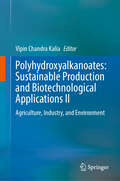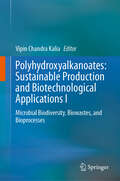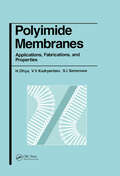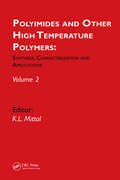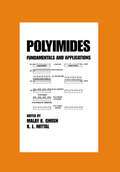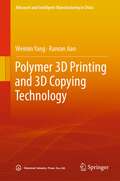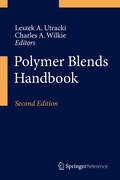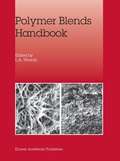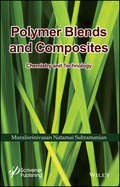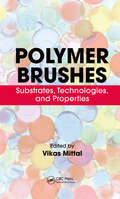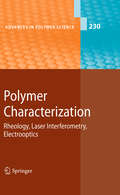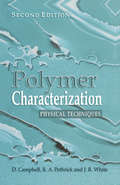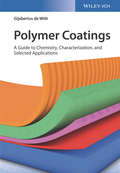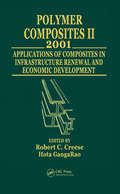- Table View
- List View
Polyhydroxyalkanoates: Agriculture, Industry, and Environment
by Vipin Chandra KaliaThis book overviews the sustainable production and diverse applications of Polyhydroxyalkanoates (PHAs), with a special focus on agriculture, industry, and the environment. It provides a comprehensive overview of the latest strategies to overcome production challenges and enhance commercial feasibility. By exploring the potential of cost-effective raw materials and genetically engineered microbes, this volume highlights innovative approaches to ferment biowastes efficiently. The book also examines how blending different PHAs and modifying their chemical structures can expand their applications, making it a must-read for those interested in biotechnological advancements. Key concepts covered include the development of biosensors, bio-indicators, and biofuels, as well as the role of biopolymers in environmental bioremediation. The chapters are organized to provide insights into technological bioprocesses that can be translated into globally competitive business proposals. Readers will discover contributions from renowned scholars who probe critical questions about sustainable PHA production and its applications in various industries. This book is essential for researchers, scholars, and practitioners in biotechnology, environmental science, and agricultural engineering. It offers valuable information for those looking to develop eco-friendly solutions and sustainable business models. Whether you are an academic or a professional in the field, this volume provides the latest research and practical insights to help you stay ahead in the rapidly evolving landscape of biopolymers.
Polyhydroxyalkanoates: Biomedical Sector
by Vipin Chandra KaliaThis book provides an in-depth analysis of recent developments in microbial diversity, molecular biology, and biotechnology related to PHA production. PHAs are highlighted as unique biopolymers that are biocompatible, bioresorbable, biodegradable, versatile, and sustainable—qualities that make them strong contenders for various biomedical applications. The chapters cover essential topics such as microbial production of PHAs from biowastes, co-digestion processes to enhance their physio-chemical properties, and challenges related to regulatory approvals and commercialization. Readers will learn about the diverse range of medical applications for PHAs including tissue engineering scaffolds, drug delivery systems, implants, anti-osteoporosis treatments, and memory enhancers. The book also addresses how these biopolymers can be fine-tuned for specific medical uses through advanced bioengineering techniques. Particular attention is given to the potential translation of these technologies into globally competitive business ventures. The volume provides expert analyses on how governmental funding agencies can identify prospective scientific R&D areas. For society at large, this book offers novel concepts about the eco-friendly and economic benefits of PHAs. Researchers in biotechnology, molecular biology, biomedical engineering, and related fields will find this book indispensable. This volume is part of a series dedicated to exploring the vast potential of bioplastics across various sectors. It serves as an essential guide for researchers aiming to achieve sustainable polyhydroxyalkanoate production while addressing critical questions about their practical applications in medicine.
Polyhydroxyalkanoates: Microbial Biodiversity, Biowastes, and Bioprocesses
by Vipin Chandra KaliaThis book highlights microbial biodiversity, biowastes, and innovative bioprocesses that contribute to creating these environmentally friendly biopolymers. The chapters discuss key concepts such as the occurrence and biosynthesis of natural and synthetic biopolymer composites, recent advances in using engineered E. coli and Pseudomonas as microbial factories revolutionizing biopolymer production, and the challenges and opportunities presented by cyanobacterial PHA research. Additionally, it investigates green synthesis methods that convert lignocellulosic biomass into PHAs and examines various feedstocks like sugar- and starch-rich waste for fermentation substrates. Researchers in biotechnology, environmental science, materials engineering, and related fields will find this book indispensable. It offers a comprehensive overview of current R&D activities to achieve sustainable PHA production. The book provides both theoretical perspectives and practical case studies, offers a wealth of knowledge to guide readers’ exploration of biopolymer production, making it a must-read for anyone dedicated to advancing eco-friendly materials science.
Polyimide Membranes: Applications, Fabrications and Properties
by H. Ohya V.V. Kudryavsev S.I. SemenovaThis is a first attempt to provide a general analysis of developments in polyimide membrane synthesis and applications. It will serve as a valuable reference for those with an interest in synthesis of polyimides, the chemistry and physical chemistry of polyimide compounds, the separation properties of membranes and in their preparation and application. It is intended as a summary of the current status of polyimide membrane research for the specialist as well as a teaching aid for graduate studies in polymer chemistry. The authors collaboration demonstrates the high level of scientific research in Russia and the active development of applied research in Japan.
Polyimides and Other High Temperature Polymers: Synthesis, Characterization and Applications, Volume 5
by Kash L. MittalThis volume documents the proceedings of the "Second International Symposium on Polyimides and Other High Temperature Polymers: Synthesis, Characterization and Applications, held in Newark, New Jersey, December 3-6, 2001. Polyimides possess many desirable attributes, so this class of materials has found applications in many technologies ranging fro
Polyimides and Other High Temperature Polymers: Synthesis, Characterization and Applications, volume 2
by K. L. MittalThis volume documents the proceedings of the Second International Symposium on Polyimides and Other High Temperature Polymers: Synthesis, Characterization and Applications, held in Newark, New Jersey, December 3-6, 2001. Polyimides possess many desirable attributes, so this class of materials has found applications in many technologies ranging from
Polyimides: Fundamentals and Applications (Plastics Engineering)
by Malay GhoshProvides coverage on the full range of topics associated with polyimides, including structure, polymer fundamentals, and product areas. The text addresses both basic and applied aspects of the subject. It details the synthesis of polyimides, polyamideimides, and flourinated polyimides, explains the molecular design of photosensitive polyimides, and more.
Polylactic Acid-Based Nanocellulose and Cellulose Composites
by Jyotishkumar ParameswaranpillaiPolylactic Acid-Based Nanocellulose and Cellulose Composites offers a comprehensive account of the methods for the synthesis, characterization, processing, and applications of these advanced materials. This book fills a gap in the literature as the only currently available book on this topic. This book: Describes the procedures for the extraction of cellulose materials from different sources and characterization methods adopted for analyzing their properties Covers properties, processing, and applications of PLA biocomposites made using the extracted cellulose Discusses the effect of reinforcement of cellulose on the biopolymer matrix and the enhancement of biopolymer properties Examines current status, challenges, and future outlook in biocomposite research and applications The book serves as a reference for researchers, scientists, and advanced students in polymer science and engineering and materials science who are interested in cellulose polymer composites and their applications.
Polymer 3D Printing and 3D Copying Technology (Advanced and Intelligent Manufacturing in China)
by Weimin Yang Ranran JianThis book focuses on 3D printing and molding/ copying technologies and approaches, which innovatively proposes the concept of polymer 3D copying technology. It introduces the two technologies of polymer 3D printing and 3D copying by analogy and elaborates the core principles and processes of polymer 3D copying technology, the composition, basic parameters and structure design of polymer 3D copying machines, precision control methods, defect generation mechanism and solutions of polymer 3D copying products, and also discussed the future development of polymer 3D copying technology. The novel concept of 3D copying is one of the major features of the book, which is particularly suited for readers who are interested in rapid prototyping and molding. The book is based on both traditional and new knowledges, with novel content and concept, focusing on both principles and engineering practice. It systematically reflects the content and application of polymer 3D printing and 3D copying technology, which can benefit researchers, engineers, and students of related majors engaged in the fields of polymer processing, rapid prototyping, 3D printing and molding/ copying, etc.
Polymer Adhesion, Friction, and Lubrication
by Hongbo ZengSpecifically dedicated to polymer and biopolymer systems, Polymer Adhesion, Friction, and Lubrication guides readers to the scratch, wear, and lubrication properties of polymers and the engineering applications, from biomedical research to automotive engineering. Author Hongbo Zeng details different experimental and theoretical methods used to probe static and dynamic properties of polymer materials and biomacromolecular systems. Topics include the use of atomic force microscopy (AFM) to analyze nanotribology, polymer thin films and brushes, nanoparticles, rubber and tire technology, synovial joint lubrication, adhesion in paper products, bioMEMS, and electrorheological fluids.
Polymer Based Bio-nanocomposites: Properties, Durability and Applications (Composites Science and Technology)
by Rajini Nagarajan Suchart Siengchin Senthilkumar Krishnasamy Chandrasekar Muthukumar Senthil Muthu Kumar ThiagamaniThis book gives a comprehensive overview of bionanocomposites, a class of materials that consist of a biopolymer matrix which is embedded with nanoparticles and natural fibres as reinforcement to produce novel material and achieve superior physico-chemical and mechanical properties. The book looks into the synthesis of various forms of nanoparticles, the fabrication methods, and the characterization of bionanocomposites. It also includes topics related to the sustainability and life prediction of bionanocomposites such as biodegradability, recycling, and re-use. An important aspect in the designing of bionanocomposites includes computational modeling, and the suitability of the bionanocomposites in various applications is presented. This book appeals to students, researchers, and scientists looking to gain fundamental knowledge, know about recent advancements in the research on bionanocomposites and their applications.
Polymer Blends Handbook
by Leszek A. Utracki Charles A. WilkieThe Polymer Blends Handbook is a fundamental reference work on polymer blends, covering all aspects: science, engineering, technology and application. It will appeal to anyone working in the field of blends, researchers as well as engineers. The Handbook is designed to be the source of information on all aspects of polymer blends. To this end the Editors have put together an international group of highly respected contributors, each an expert in his chosen subjects.
Polymer Blends Handbook
by L. A. UtrackiThis unique handbook is a fundamental reference on polymer blends, covering all aspects: science, engineering, technology, and application. The editor has put together an international group of highly respected contributors to create an exceptional source of information invaluable for anyone blending polymers.
Polymer Blends and Alloys (Plastics Engineering Ser. #52)
by Gabriel O. Shonaike George P. SimonDistinguishing among blends, alloys and other types of combinations, clarifying terminology and presenting data on new processes and materials, this work present up-to-date and effective compounding techniques for polymers. It offers extensive analyses on the challenging questions that surround miscibility, compatibility, dynamic processing, interaction/phase behaviour, and computer simulations for predicting behaviours of polymer mixture and interaction.
Polymer Blends and Composites: Chemistry and Technology
by Muralisrinivasan Natamai SubramanianBecause it is critically important to manufacture quality products, a reasonable balance must be drawn between control requirements and parameters for improved processing method with respect to plastics additives. An important contribution to the commercial polymer industry, Polymer Blends and Composites is one of the first books to combine plastics additives, testing, and quality control. The book is a comprehensive treatise on properties that provides detailed guidelines for selecting and using blends and composites for applications. A valuable resource for operators, processors, engineers, chemists, the book serves to stimulate those already active in natural polymer composites.
Polymer Brushes: Substrates, Technologies, and Properties
by Sandeep Kumar: Substrates, Technologies, and PropertiesPolymer Brushes: Substrates, Technologies, and Properties covers various aspects of polymer brush technology, including synthesis, properties, performance, and applications. It presents both experimental details and theoretical insights to enable a better understanding of the brush system.After an overview of polymer brush systems, the book discuss
Polymer Characterization
by Jean-François Joanny Karel Dusˇek-Shear-Induced Transitions and Instabilities in Surfactant Wormlike Micelles By S. Lerouge, J.-F. Berret -Laser-Interferometric Creep Rate Spectroscopy of Polymers By V. A. Bershtein, P. N. Yakushev -Polymer Nanocomposites for Electro-Optics: Perspectives on Processing Technologies, Material Characterization, and Future Application K. Matras-Postolek, D. Bogdal
Polymer Characterization: Physical Techniques, 2nd Edition
by Dan Campbell Richard A. Pethrick Jim R. WhiteDiscerning the properties of polymers and polymer-based materials requires a good understanding of characterization. This revised and updated text provides a comprehensive survey of characterization methods within its simple, concise chapters. Polymer Characterization: Physical Techniques, provides an overview of a wide variety of characterization methods, which makes it an excellent textbook and reference. It starts with a description of basic polymer science, providing a solid foundation from which to understand the key physical characterization techniques. The authors explain physical principles without heavy theory and give special emphasis to the application of the techniques to polymers, with plenty of illustrations. Topics covered include molecular weight determination, molecular and structural characterization by spectroscopic techniques, morphology and structural characterization by microscopy and diffraction, and thermal analysis. This edition contains a new chapter on surface analysis as well as some revised problems and solutions. The concise treatment of each topic offers even those with little prior knowledge of the subject an accessible source to relevant, simple descriptions in a well-organized format.
Polymer Chemistry
by Sebastian Koltzenburg Michael Maskos Oskar NuykenThis comprehensive textbook describes the synthesis, characterization and technical and engineering applications of polymers. Offering a broad and balanced introduction to the basic concepts of macromolecular chemistry and to the synthesis and physical chemistry of polymers, it is the ideal text for graduate students and advanced Masters students starting out in polymer science. Building on the basic principles of organic chemistry and thermodynamics, it provides an easily understandable and highly accessible introduction to the topic. Step by step, readers will obtain a detailed and well-founded understanding of this vibrant and increasingly important subject area at the intersection between chemistry, physics, engineering and the life sciences. Following a different approach than many other textbooks in the field, the authors, with their varying backgrounds (both from academia and industry), offer a new perspective. Starting with a clear and didactic introduction, the book discusses basic terms and sizes and shapes of polymers and macromolecules. There then follows chapters dedicated to polymers in solutions, molar mass determination, and polymers in the solid state, incl. (partially) crystalline or amorphous polymers as well as their application as engineering materials. Based on this information, the authors explain the most important polymerization methods and techniques. Often neglected in other textbooks, there are chapters on technical polymers, functional polymers, elastomers and liquid crystalline polymers, as well as polymers and the environment. An overview of current trends serves to generate further interest in present and future developments in the field. This book is the English translation of the successful German textbook "Polymere", which was awarded the Chemical Industry in Germany's 2015 literature Prize ("Literaturpreis des Fonds der Chemischen Industrie") for its innovative, novel approach, and its good accessibility and readability, while at the same time providing comprehensive coverage of the field of polymer science.
Polymer Chemistry
by Sebastian Koltzenburg Michael Maskos Oskar NuykenAwarded the Literature Prize of the VCI This comprehensive textbook describes the synthesis, characterization and technical and engineering applications of polymers. Polymers are unique molecules and have properties different from any other class of materials. We encounter them in everyday life, not only in the form of the well-known, large-volume plastics such as PE or PP or the many other special polymers, some of which are very specifically modified but also in nature as polymeric biomolecules, such as DNA. Our life, as we know it, would not only be completely different without macromolecules but it would also be biologically impossible. This textbook provides a broad knowledge of the basic concepts of macromolecular chemistry and the unique properties of this class of materials. Environmentally relevant topics, such as biopolymers and microplastic, which should not be missing in a contemporary textbook are also covered. Building on basic knowledge of organic chemistry and thermodynamics, the book presents an easy-to-understand yet in-depth picture of this very dynamic and increasingly important interdisciplinary science that involves elements of chemistry, physics, engineering, and the life sciences. Readers of this work can confirm their understanding of the text at the end of each chapter by working through a selection of exercises. In writing the book, great importance was attached to good readability despite the necessary depth of detail. It is a book that is just as suitable for students of chemistry and related courses as it is for the applied scientist in an industrial environment. The first edition of this work is so far the only textbook on polymer chemistry to be awarded the Literature Prize of the Fund of the German Chemical Industry Association in 2015.
Polymer Chemistry: The Basic Concepts
by Timothy P. LodgeA well-rounded and articulate examination of polymer properties at the molecular level, Polymer Chemistry focuses on fundamental principles based on underlying chemical structures, polymer synthesis, characterization, and properties. It emphasizes the logical progression of concepts and provide mathematical tools as needed as well as fully derived problems for advanced calculations. The much-anticipated Third Edition expands and reorganizes material to better develop polymer chemistry concepts and update the remaining chapters. New examples and problems are also featured throughout. This revised edition: Integrates concepts from physics, biology, materials science, chemical engineering, and statistics as needed. Contains mathematical tools and step-by-step derivations for example problems. Incorporates new theories and experiments using the latest tools and instrumentation and topics that appear prominently in current polymer science journals. Polymer Chemistry, Third Edition offers a logical presentation of topics that can be scaled to meet the needs of introductory as well as more advanced courses in chemistry, materials science, polymer science, and chemical engineering.
Polymer Coatings: A Guide to Chemistry, Characterization, and Selected Application
by Gijsbertus De WithA practical guide to polymer coatings that covers all aspects from materials to applications Polymer Coatings is a practical resource that offers an overview of the fundamentals to the synthesis, characterization, deposition methods, and recent developments of polymer coatings. The text includes information about the different polymers and polymer networks in use, resins for solvent- and water-based coatings, and a variety of additives. It presents deposition methods that encompass frequently used mechanical and electrochemical approaches, in addition to the physical-chemical aspects of the coating process. The author covers the available characterization methods including spectroscopic, morphological, thermal and mechanical techniques. The comprehensive text also reviews developments in selected technology areas such as electrically conductive, anti-fouling, and self-replenishing coatings. The author includes insight into the present status of the research field, describes systems currently under investigation, and draws our attention to yet to be explored systems. This important text: • Offers a thorough overview of polymer coatings and their applications • Covers different classes of materials, deposition methods, coating processes, and ways of characterization • Contains a text that is designed to be accessible and helps to apply the acquired knowledge immediately • Includes information on selected areas of research with imminent application potential for functional coatings Written for chemists in industry, materials scientists, polymer chemists, and physical chemists, Polymer Coatings offers a text that contains the information needed to gain an understanding of the charaterization and applications of polymer coatings.
Polymer Coatings: Technologies And Applications
by Jyotishkumar Parameswaranpillai Suchart Siengchin Sanjay Mavinkere RangappaPolymer Coatings: Technologies and Applications provides a comprehensive account of the recent developments in polymer coatings encompassing novel methods, techniques, and a broad spectrum of applications. The chapters explore the key aspects of polymer coatings while highlighting fundamental research, different types of polymer coatings, and technology advances. This book also integrates the various aspects of these materials from synthesis to application. Current status, trends, future directions, and opportunities are also discussed. FEATURES Examines the basics to the most recent advances in all areas of polymer coatings Serves as a one-stop reference Discusses polymer-coated nanocrystals and coatings based on nanocomposites Describes morphology, spectroscopic analysis, adhesion, and rheology of polymer coatings Explores conducting, stimuli-responsive, self-healing, hydrophobic and hydrophilic, antifouling, and antibacterial polymer coatings Covers modeling and simulation With contributions from the top international researchers from industry, academia, government, and private research institutions, both new and experienced readers will benefit from this applications-oriented book. Sanjay Mavinkere Rangappa is a research scientist at the Natural Composites Research Group Lab, Academic Enhancement Department, King Mongkut’s University of Technology North Bangkok, Thailand. Jyotishkumar Parameswaranpillai is a research professor at the Center of Innovation in Design and Engineering for Manufacturing, King Mongkut’s University of Technology North Bangkok, Thailand. Suchart Siengchin is a professor at and president of King Mongkut’s University of Technology North Bangkok, Thailand.
Polymer Composites II: Composites Applications in Infrastructure Renewal and Economic Development
by Robert C. Creese Hota GangaRaoBased on polymer conferences held in 1999 and 2001, Polymer Composites II: Composites Applications in Infrastructure Renewal and Economic Development is a collection of status reports, success stories, and new opportunities from specific composite applications in infrastructure renewal that provide insight to the resulting economic development and effects. This volume brings together multidisciplinary experts involved with polymer composites who validate their design, construction, and performance and present the role that composites play in infrastructure renewal, detail the technical and regualtory barriers, identify helpful agencies, and estimate the possibilities of economic development.
Polymer Composites and Nanocomposites for X-Rays Shielding (Composites Science and Technology)
by It Meng Low Nurul Zahirah Noor AzmanThis book focuses on the processing, materials design, characterisation, and properties of polymer composites and nanocomposites for use as electromagnetic radiation shielding materials and to enhance radiation shielding capacity in order to meet the safety requirements for use in medical X-ray imaging facilities. It presents an in-depth analysis of materials synthesis methods such as melt-mixing, ion-implantation, solution casting and electrospinning. In addition, it measures the X-ray attenuation behaviour of fabricated composites and nanocomposites in four major types of X-ray equipment, namely general radiography, mammography, X-ray absorption spectroscopy and X-ray fluorescence spectroscopy units. Given its scope, the book will benefit researchers, engineers, scientists and practitioners in the fields of medical imaging, diagnostic radiology and radiation therapy.
